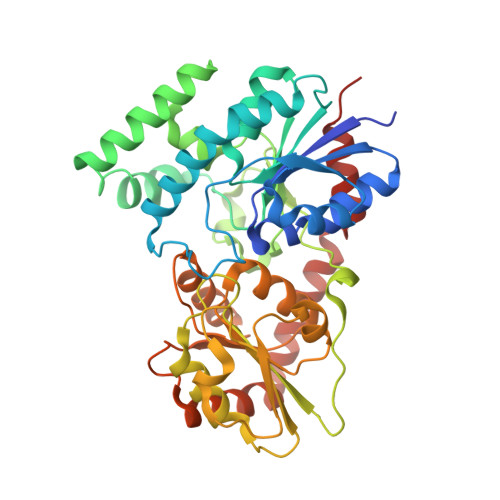Design of a chimeric glycosyltransferase OleD for the site-specific O-monoglycosylation of 3-hydroxypyridine in nosiheptide.
Zhao, L., Xu, Y., Chen, M., Wu, L., Li, M., Lu, Y., Lu, M., Chen, Y., Wu, X.(2023) Microb Biotechnol 16: 1971-1984
- PubMed: 37606280
- DOI: https://doi.org/10.1111/1751-7915.14332
- Primary Citation of Related Structures:
7XX4 - PubMed Abstract:
To identify the potential role of the 3-hydroxyl group of the pyridine ring in nosiheptide (NOS) for its antibacterial activity against Gram-positive pathogens, enzymatic glycosylation was utilized to regio-selectively create a monoglycosyl NOS derivative, NOS-G. For this purpose, we selected OleD, a UDP glycosyltransferase from Streptomyces antibioticus that has a low productivity for NOS-G. Activity of the enzyme was increased by swapping domains derived from OleI, both single and in combination. Activity enhancement was best in mutant OleD-10 that contained four OleI domains. This chimer was engineered by site-directed mutagenesis (single and in combination) to increase its activity further, whereby variants were screened using a newly-established colorimetric assay. OleD-10 with I117F and T118G substitutions (FG) had an increased NOS-G productivity of 56%, approximately 70 times higher than that of wild-type OleD. The reason for improved activity of FG towards NOS was structurally attributed to a closer distance (<3 Å) between NOS/sugar donor and the catalytic amino acid H25. The engineered enzyme allowed sufficient activity to demonstrate that the produced NOS-G had enhanced stability and aqueous solubility compared to NOS. Using a murine MRSA infection model, it was established that NOS-G resulted in partial protection within 20 h of administration and delayed the death of infected mice. We conclude that 3-hydroxypyridine is a promising site for structural modification of NOS, which may pave the way for producing nosiheptide derivatives as a potential antibiotic for application in clinical treatment.
Organizational Affiliation:
Laboratory of Chemical Biology, College of Life Sciences and Technology, China Pharmaceutical University, Nanjing, Jiangsu Province, PR China.















